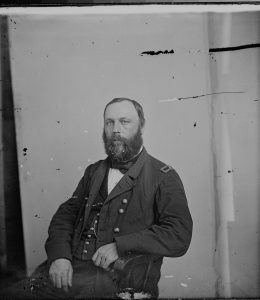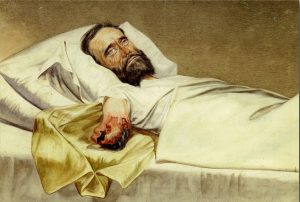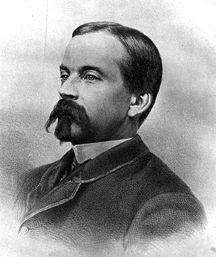Table of Contents
The Shaping of American Medical Science
“A visit to the Army Medical Museum in Washington is replete with interest and information…To the student of surgery and medicine it affords advantages which are offered nowhere in this country—and in some respects, it may be said, not elsewhere in the world—and hence it possesses a national value as an institution of learning aside from its more popular character as a collection of curious objects.”[1]

Surgeon General William Hammond issued Circular No. 2 May 21, 1862, which provided for the establishment of the Army Medical Museum. The museum was constructed for the purpose of “illustrating the injuries and diseases that produce death or disability during war, and thus affording materials for precise methods of study or problems regarding the diminution of mortality and alleviation of suffering in armies.”[2] Military medicine was complex and at the beginning of the American Civil War most surgeons had little to no experience treating bullet wounds, camp, and hospital diseases. The museum was created to teach physicians the basic principles of military medicine. Circular No. 2 directed medical officers to “diligently collect and forward to the office of the Surgeon General all specimens of morbid anatomy, surgical or medical, which may be regarded as valuable; together with projectiles and foreign bodies removed; and such other matter as may prove of interest in the study of military medicine and surgery.”[3] Once the project got underway American physicians saw the museum as a new source of medical vitality, a center of learning that could institutionalize pathology and lay the foundation to both reform and develop American medicine along more scientific guidelines.

The most effective vehicle for the transmission of this knowledge to the large body of American physicians was the Civil War case report. Thus Hammond issued Circular No. 5 shortly after Circular No. 2, which required that all physicians write and submit a case history or essay along with each specimen or photograph that was submitted to museum. The Circular requested that, “All medical officers cooperate in this undertaking by forwarding to this office such sanitary, topographical, medical and surgical reports, details of cases, essays and the results of investigations and inquiries as may be of value for this work, which full credit will be given in forthcoming volumes.” Circular No. 5 and the subsequent publication of the Medical and Surgical History of the War of the Rebellion, published both case histories and visual representations of the wartime cases. The case history was important—it was meant to standardize the experience of the observer and reinforce the diagnosis of the expert. Displayed alongside medical and surgical specimens and photographs, the case history established a relation between the visual representation of disease and the physician’s analyses of specimens, tissues and organs. There was now a specific medical model: Physicians were required to diagnose, treat, monitor, and perform an autopsy culminating in the relationship with the body with the delivery of the case report and specimen or photograph to the Army Medical Museum. Both circulars gave physicians unprecedented access to specimens and bodies on a scale never before experienced in American medicine and created new opportunities in which to develop ideas about medicine and disease. Hammond noted, “…It is scarcely necessary to remind the medical officers of the regular and volunteer services that through the means in question much may be done to advance the science which we all have so much at heart, and to establish landmarks which will serve to guide us in the future.”[4]

It is an impossible task to describe each photograph, specimen, case report, narrative of service, or essay that was submitted as per the orders of Circular No.2. The index of contributors found in the Army Medical Museum catalogue or the Medical and Surgical History of the War of the Rebellion is long and speaks to the enormity of the project. As George Otis noted in 1865, “The extent of these materials is simply enormous. The returns are of as huge proportions as the armies that have been engaged in active operations for the last four years. The great body of the medical officers have made the reports required of them with commendable diligence and promptitude, and their zeal is the more deserving of praise when the engrossing nature of their field duties is considered. The result has been the accumulation of a mass of facts and observations in military surgery of unprecedented magnitude.”[5] George Otis’s colleague at the museum, medical section curator Joseph Woodward recalled years later “that the records thus accumulated embraced over sixteen thousand folio volumes of manuscript record books” and “several tons of manuscript reports and papers.”[6] In short, the Union medical department’s programmatic attempt to develop medical science brought an unprecedented number of American physicians into the domain of medical science—and began the process of setting new investigative standards for American physicians.

The process of collecting medical and surgical specimens and the collection itself allowed for the creation of new forms of analysis, a new way to think about diseases and wound trauma, and this promise for medicine had a profound effect on the individual physician. The museum’s surgical section curator John Brinton noted that “professional zeal had been excited” simply because collecting specimens placed physicians in the domain of scientific medicine they were forced to identify with the gross pathological specimen, to see the object of disease. He noted that never before in American medicine had there been “so great an activity and development and so earnest an effort to master the unsolved problems of the past.”[7] The physician Edward H. Smith also reasoned, “if there is any benefit from the sad struggle of the age, it is that medical officers can fully justify looking for information and present the information for the world’s future use…..The use of limbs and organs, and operations once deemed experimental will in future use be instilled to our confidence because of the keen, careful, and honoring eye of experience.”[8]
There was unparalleled loss caused by the Civil War. Throughout the war and after, Americans began the uneasy process of defining a new relationship with death, and the “living had to find meaning in the dead.” The museum was one way to make sense of the death, to find larger meaning in it, or to imbue the war dead with a sense of national importance. As one observer recalled, “We have visited the museum in its new and permanent location, and can cordially endorse the assertion of the Surgeon General that, ‘by its array of indisputable facts, supported and enriched by full reports, it supplies instruction otherwise unattainable, and preserves, for future application, the dearly bought experience of four years of war,’ and that, ‘apart from its great usefulness, it is also an honorable record of those medical officers whose contributions constitute its value, and whose incentive to their self-imposed labors has been the desire to elevate their profession.”[9]
About the Author
Dr. Shauna Devine is an historian of Civil War and American medicine. She has a Ph.D in medical history and currently holds a joint appointment as an assistant professor at the Schulich School of Medicine and in the Department of History at Western University. She also sits on the Board of Directors for the National Museum of Civil War Medicine and is a historical advisor for the PBS Civil War drama, Mercy Street.
Further Reading
Shauna Devine, Learning from the Wounded: The Civil War and the Rise of American Medical Science (UNC Press, 2014), chapter one.
Footnotes
[1] Louis Bagger, Appleton’s Journal, (New York: March 1, 1873), 294-297, 297.
[2] George A. Otis, „Notes on the Contributions of the Army Medical Museum,” Feb. 7, 1878. Scientific and Historical Reports: Records of the Record and Pension Office, 1814-1919, File A, Entry 41, RG 94, NARA.
[3] “Circulars and Circular Letters of the Surgeon General’s Office” Circular No. 2 issued, May 21, 1862, Entry 63, Box One, p. 23, RG 112, NARA.
[4] Ibid.
[5] Joseph K. Barnes, Surgeon General United States Army, Medical and Surgical History of the War of the Rebellion 6 vols., (Washington, DC: U.S. Government Printing Office, 1870-1888), 2: 2. List of Reporters and Operators pp. I-XVI.
[6] Joseph Woodward, “The Medical Staff of the United States Army and its Scientific Work.” Delivered to the International Medical Congress at Philadelphia, 1876, 8.
[7] John Brinton, “Address to the Graduating Class of Jefferson Medical College, April 27, 1892,” 2. John Brinton Manuscript Collection, RG 124, OHA, NMHM.
[8] Edward H. Smith to William Hammond, February 3, 1863, Scientific and Historical Reports: Records of the Record and Pension Office, 1814-1919 File A, Entry 621,RG 94, NARA.
[9] Quoted in Shauna Devine, Learning from the Wounded: The Civil War and the Rise of American Medical Science (UNC Press, 2014), chapter one.



Leave a Reply
You must be logged in to post a comment.